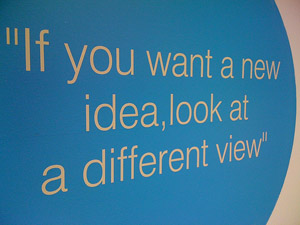
Source: “New Idea,” David Roessli, Flickr
When you write an essay, you are joining a conversation. Even if you have a completely new idea, it will still relate to ideas that other people have had. Your idea might be different and original, but it will still be related to existing ideas.
This is why it’s a good move to begin your essay by describing this conversation. You can start off with what other people have said and then tell readers about your ideas.
This means you have to think backward, which is difficult for some people. This requires figuring out how other people’s ideas contradict or contrast with your own. You must think of ideas you don’t agree with, in other words.

Source: “Diggin’ Myself a Hole,” code poet, Flickr
Let’s say you are writing about how good it feels to do hard physical work. Instead of starting your essay with a statement like “There is nothing like hard physical work to make you feel whole and healthy and alive,” you might start with a statement like this: “Many people like to avoid hard physical work whenever they can. They would hire someone to mow the lawn rather than do it themselves. They would rent a machine to dig a hole rather than get out a shovel. They would wait for a bus for thirty minutes rather than walk ten blocks down the street.”
Of course, you won’t end your introduction there. You are going to add a contrast or contradicting idea and then state your thesis. In this case, the thesis would be something about the good feeling you get from physical work. Before we talk about your thesis statement, however, let’s practice thinking backward.
Thinking Backward
Read each statement that pops up in the next exercise. Decide whether it agrees with or is contrary to the practice thesis, “Small differences are worth making.” When you have an answer in mind, choose “Agrees” or “Contrary” from the pull-down menu.

Now that you are getting good at thinking backward, let's see if you can think of some contrary statements on your own.
 Using your notes, write at least five more statements that are contrary to the thesis “Small differences are worth making.” Be sure that your contrary statements are truly contrary. In other words, be sure your contrary statements support the opposite idea that “small differences are not worth making.” When you’re finished, check your responses against the Self-check questions below. Revise your ideas if you need to and then check your understanding to see some possible responses.
Using your notes, write at least five more statements that are contrary to the thesis “Small differences are worth making.” Be sure that your contrary statements are truly contrary. In other words, be sure your contrary statements support the opposite idea that “small differences are not worth making.” When you’re finished, check your responses against the Self-check questions below. Revise your ideas if you need to and then check your understanding to see some possible responses. 
Source: “Fortune,” Dyanna Pedroza, Flickr
Note: You don’t have to start each statement with “Some people think . . .” You can use variations of this phrase such as “Many people believe that . . . ,” “I know a friend who thinks that . . . ,” or “I used to think that . . .”
The phrase you can’t use is “I think that . . .” because this statement will not produce an idea that is the opposite of your thesis and the opposite of what you think.
Self-check
__ Do all of the statements you wrote in your notes support the opposite idea of your thesis,
that small differences are not worth making?
__ Do all of the statements start with a phrase such as “Many people think . . .” that identifies someone
else as the person who thinks the statements are true?
__ Do you disagree with all of these statements? After each statement could you add “But I don’t agree”? (You should be able to!)
Sample Responses:
- Many people believe that that it’s a waste of time to wash some of the dishes if you don’t have time to wash them all.
- Some people think that throwing away trash when you eat at a fast food restaurant is pointless if other people have left the trash for someone else to pick up.
- Many people think that taking a cloth bag to the grocery store is a silly idea when most shoppers use the plastic bags the store provides.
- I know a friend who thinks that you should wait to start writing a paper until you have enough time to finish the whole thing.
- I used to think that it was pointless to conserve water by turning it off when you brushed your teeth, especially when other people were using gallons and gallons of water on their lawns.
Thinking Forward
Now it’s time to think straight ahead, to say what YOU believe, what YOU think, and what YOU see as the truth. It’s time to write your thesis statement.
If you planned well before you started your introduction, you know what your thesis is. You have probably also looked it over, improved upon it, and revised it to make sure that your thesis statement is ready for your essay.

Source: “Middle of the Road,” kagey_b, Flickr
It’s easy to think of a thesis that is for or against the prompt. That’s what you did earlier in this section. You used a thesis statement that was FOR seeing small differences as worth making. You could, of course, write the opposite: “small differences are not worth making.”
In addition to being completely for or against an idea, you could also take a qualified position: “small differences are worth making most of the time but not all the time.”
When you are deciding on a thesis, always consider the gray area between for and against positions.